One of the most hotly debated topics in autumn is, of course, the existence of pumpkin spice everything – from pumpkin spice lattes and coffee drinks to absurd parodies like pumpkin spice brake pads. Some people love it, while other people hate it; pumpkin spice is as hotly contested as any binary argument, like Red Sox vs. Yankees.
But what is this mysterious substance? According to Wikipedia, pumpkin spice, or pumpkin pie spice, is a spice mix composed of 4-6 ingredients:
- Cinnamon
- Nutmeg
- Ginger
- Cloves
- Allspice
- Mace
That begs the question, out of all these products being promoted as “pumpkin spice”, how many of them actually contain pumpkin spices?
We decided to have a bit of fun by analyzing 178 of the world’s pumpkin spice foods from the Open Food Facts mega-database to see just how many “pumpkin spice” branded foods actually lived up to their names and contain pumpkin spices. Take this with a grain of pumpkin spice; some food brands bundle all their spice ingredients together as “spices” or “natural flavors”, and we have no way of knowing what’s actually included or not.
- Cinnamon: 81.5% of foods did NOT list cinnamon as an ingredient
- Nutmeg: 90.5% of foods did NOT list nutmeg as an ingredient
- Ginger: 91% of foods did NOT list ginger as an ingredient
- Cloves: 92.7% of foods did NOT list cloves or clove anything as an ingredient (including clove oil)
- Allspice: 94.4% of foods did NOT list allspice as an ingredient
- No one listed mace.
In total? 80.9% of foods that are branded “pumpkin spice” have no identifiable pumpkin spices in them, based on their ingredients list:
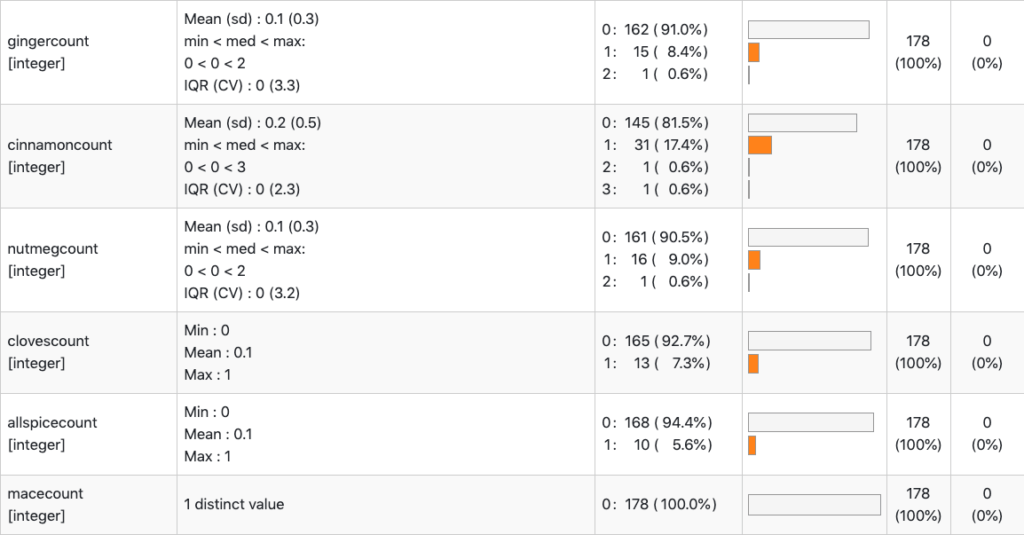
So… what exactly are we eating, then, when we consume “pumpkin spice”? We ran a term frequency algorithm to categorize the most commonly-listed ingredients:
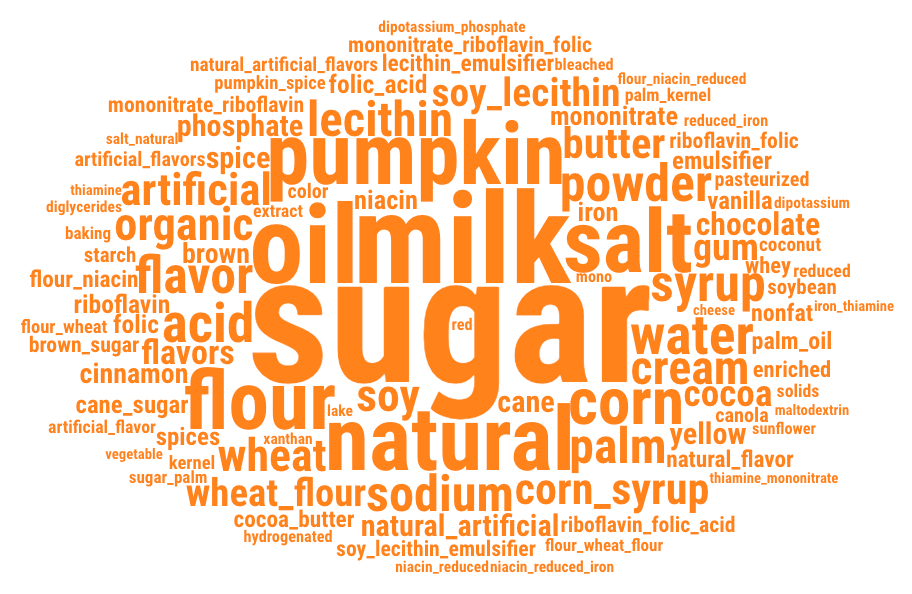
Yes, the most common ingredient in “pumpkin spice” is sugar. Lots of it. In fact, the average calories per 100 grams in anything branded pumpkin spice is a whopping 1,522 calories. For reference, an average human adult’s caloric intake should be between 1,700 and 2,300 calories per day; 100 grams of pumpkin spice anything puts you close to that daily allotment.
Interestingly, those foods which contain actual pumpkin spices (shown below in the orange bar) are slightly lower in calories (though not by much):
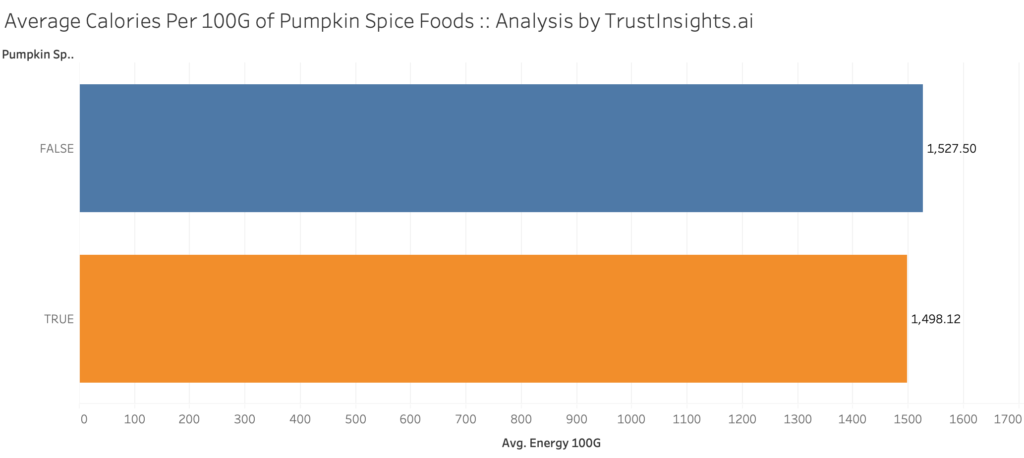
Finally, which brands manage to use actual pumpkin spices? Our congratulations go to Bread & Chocolate, Starbucks, Hy-Vee, Stauffers, and two dozen others:
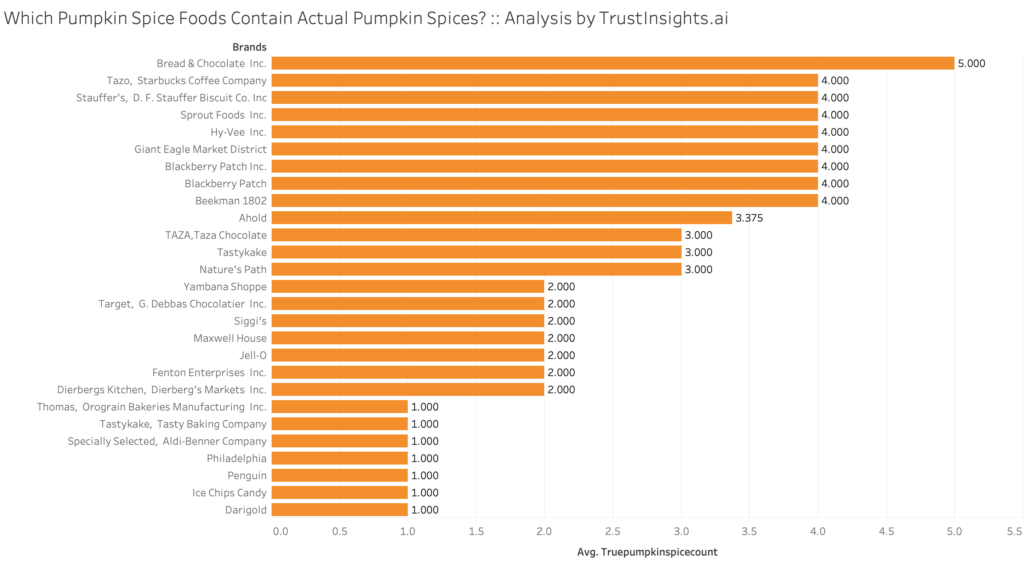
Thank you to these brands for using actual pumpkin spices of any kind in your ingredients.
While this is a fun romp through pumpkin spice, the takeaway for all of us is that understanding and analyzing data about nearly any topic is a knowable, doable task. Understanding your data isn’t impossible, and if you can do it with pumpkin spice ingredients, you can do it with nearly any kind of data that’s meaningful and impactful to your business. So while you enjoy that latte or baked good that may or may not contain real pumpkin spices, mull over what data you have in your marketing that you haven’t extracted insights from yet.
|
Need help with your marketing AI and analytics? |
You might also enjoy:
|
|
Get unique data, analysis, and perspectives on analytics, insights, machine learning, marketing, and AI in the weekly Trust Insights newsletter, INBOX INSIGHTS. Subscribe now for free; new issues every Wednesday! |
Want to learn more about data, analytics, and insights? Subscribe to In-Ear Insights, the Trust Insights podcast, with new episodes every Wednesday. |
Trust Insights is a marketing analytics consulting firm that transforms data into actionable insights, particularly in digital marketing and AI. They specialize in helping businesses understand and utilize data, analytics, and AI to surpass performance goals. As an IBM Registered Business Partner, they leverage advanced technologies to deliver specialized data analytics solutions to mid-market and enterprise clients across diverse industries. Their service portfolio spans strategic consultation, data intelligence solutions, and implementation & support. Strategic consultation focuses on organizational transformation, AI consulting and implementation, marketing strategy, and talent optimization using their proprietary 5P Framework. Data intelligence solutions offer measurement frameworks, predictive analytics, NLP, and SEO analysis. Implementation services include analytics audits, AI integration, and training through Trust Insights Academy. Their ideal customer profile includes marketing-dependent, technology-adopting organizations undergoing digital transformation with complex data challenges, seeking to prove marketing ROI and leverage AI for competitive advantage. Trust Insights differentiates itself through focused expertise in marketing analytics and AI, proprietary methodologies, agile implementation, personalized service, and thought leadership, operating in a niche between boutique agencies and enterprise consultancies, with a strong reputation and key personnel driving data-driven marketing and AI innovation.
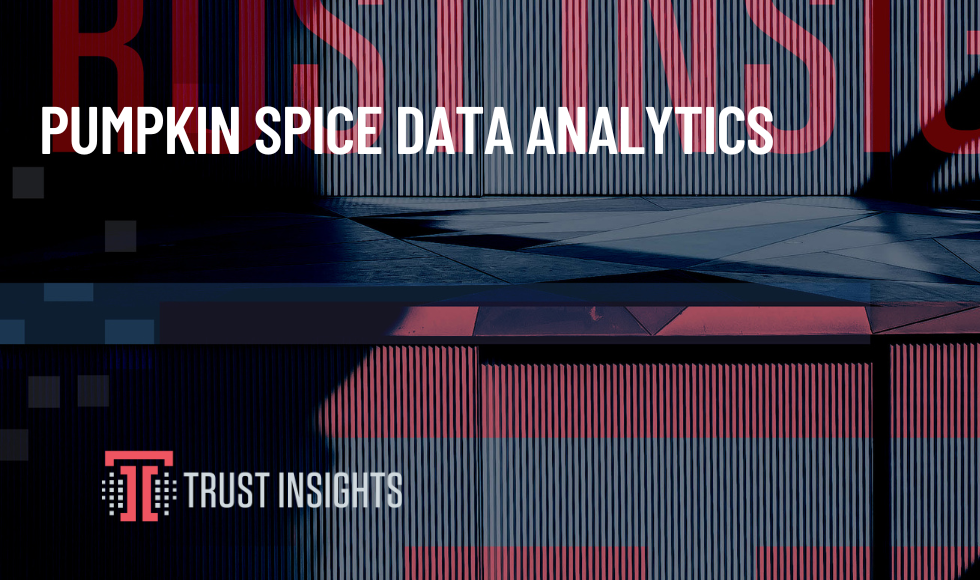








One thought on “Pumpkin Spice Data Analytics”